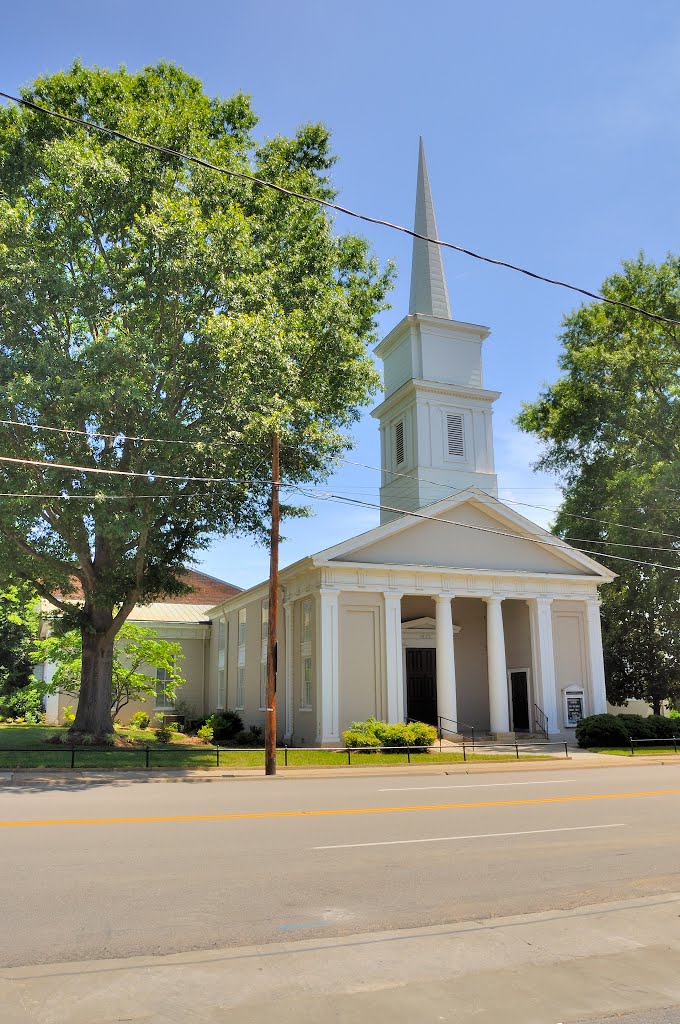
Park the car and stroll through the beautiful town of Farmville. Take a moment to learn about Farmville’s history and relish the bucolic surroundings.
In Farmville’s Historic District, Main Street features gorgeous late-19th– and early-20th-century brick commercial buildings along with three Victorian Gothic and neoclassical churches. Did we mention a post office built in 1917?
At the northern end of the downtown district, brick tobacco warehouses from the late 1800s remind us of the critical role tobacco processing played in the town’s economy.
The residential districts of Farmville feature architectural styles including Federal, Greek revival, Italianate, Gothic Revival, colonial, Tudor revival and Craftsman.
Here are a few highlights:
The Whitfield Building – 308 N. Main St.
Though Farmville was established in 1798, the oldest surviving structure is this two-story brick building probably dating to the early 1840s. The building was designed from noted architect Asher Benjamin’s early 19th-century books on architecture. Of interest is the Greek Key over the windows on the second floor.
 The Farmville Presbyterian Church – 200 W. 3rd St.
The Farmville Presbyterian Church – 200 W. 3rd St.
This church features an original rectangular frame built circa 1828. In 1859, a steeple was added. When the news of President Lincoln’s death arrived, the commandant of the Union Army Post in Farmville got permission to use the church for a memorial service the following day.
 The Hardy House – 303 Beech St.
The Hardy House – 303 Beech St.
Located just north of the Longwood University campus at the corner of Randolph and Beech streets, this home was originally called the Berkeley Hardy House. It was built in 1840 and previously owned by a doctor and lieutenant colonel in the Confederate army, who used the home as an operating room and office. In 2008, Longwood acquired the house to be used for the Conferences and Scheduling department.
High St.
Check out the Cunningham-Bugg House, 700 High Street, the former residence of Mrs. Fred Bugg, mother of Dr. Robert Bugg, who served as headmaster at St. Christopher’s School in Richmond. Further up High Street you will see other Victorian-style homes that were built during the late 19th century.
Beech St.
The McKinney House, located at 408 Beech Street, was previously owned by Phillip W. McKinney, Virginia’s governor from 1890 to 1894. McKinney’s brother purchased a nearby home in 1899, The Wade-McKinney House, located at 308 Beech Street, and later donated it to Historic Farmville Inc. in 1987. The Jackson House, 304 Beech Street is where General Robert E. Lee visited on the morning of April 7 to meet with Confederate Secretary of War John Cabell Breckinridge, Quartermaster General A. R. Lawson, and Commissary General I. M. St John. The home was first built in 1837 by Patrick Henry Jackson, a wealthy tobacconist and Confederate supporter. Farmville’s very own Mary T. Riddle purchased the
Thornton House, located at 309 Beech Street, in 1836. She was the first woman to purchase property in her own name in Farmville. The home was later sold to John and Martha Thornton, who had three sons who became professors and teachers.
 The Civil Rights Walking Trail – In 1951, over 450 students, led by 16-year-old Barbara Johns, staged a walkout at the Robert R. Moton High School to protest the inadequate and overcrowded facilities African-Americans faced. The Civil Rights Walking Trail carries you through town from several important sites to R.R. Moton Museum, where the historic walkout took place. Sites on the tour are identified by a Civil Rights Walking Tour logo on the sidewalk.
The Civil Rights Walking Trail – In 1951, over 450 students, led by 16-year-old Barbara Johns, staged a walkout at the Robert R. Moton High School to protest the inadequate and overcrowded facilities African-Americans faced. The Civil Rights Walking Trail carries you through town from several important sites to R.R. Moton Museum, where the historic walkout took place. Sites on the tour are identified by a Civil Rights Walking Tour logo on the sidewalk.
Farmville on foot will lead you on a walk through the past – a lot of history, a lot of fun!
